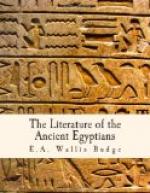THE LEGEND OF RA AND ISIS
This Legend is found written in the hieratic character upon a papyrus preserved in Turin, and it illustrates a portion of the preceding Legend. We have seen that Ra instructed Thoth to draw up a series of spells to be used against venomous reptiles of all kinds, and the reader will perceive from the following summary that Ra had good reason for doing this. The Legend opens with a list of the titles of Ra, the “self-created god,” creator of heaven, earth, breath of life, fire, gods, men, beasts, cattle, reptiles, feathered fowl, and fish, the King of gods and men, to whom cycles of 120 years are as years, whose manifold names are unknown even by the gods. The text continues: “Isis had the form of a woman, and knew words of power, but she was disgusted with men, and she yearned for the companionship of the gods and the spirits, and she meditated and asked herself whether, supposing she had the knowledge of the Name of Ra, it was not possible to make herself as great as Ra was in heaven and on the earth? Meanwhile Ra appeared in heaven each day upon his throne, but he had become old, and he dribbled at the mouth, and his spittle fell on the ground. One day Isis took some of the spittle and kneaded up dust in it, and made this paste into the form of a serpent with a forked tongue, so that if it struck anyone the person struck would find it impossible to escape death. This figure she placed on the path on which Ra walked as he came into heaven after his daily survey of the Two Lands (i.e. Egypt). Soon after this Ra rose up, and attended by his gods he came into heaven, but as he went along the serpent drove its fangs into him. As soon as he was bitten Ra felt the living fire leaving his body, and he cried out so loudly that




